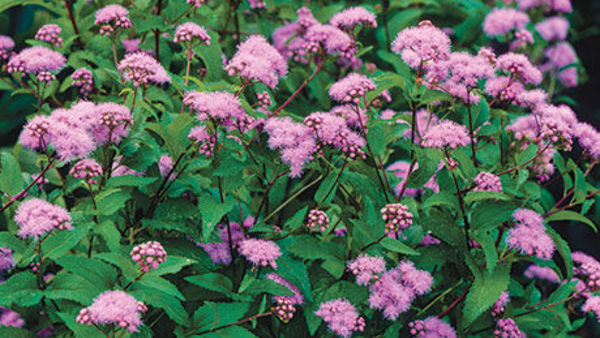1. Crape Myrtle

Name: Lagerstroemia indica cvs.
USDA Hardiness Zones: 7 to 9
Size: 8 to 30 feet tall and 6 to 15 feet wide
Conditions: Full sun; average soil; drought tolerant
Gracefully lining highway medians and busy avenues, crape myrtles flourish in our hot, humid summers and mild winters. In summer, the trees are covered with lavender, white, or watermelon-colored blooms, which look like crinkled tissue paper. Leaves blaze yellow or orange in autumn, then drop to reveal muscular tan branches and exfoliating bark. This plant shrugs off drought and neglect, but it requires occasional sucker pruning and limbing up into tree form.
2. Texas Bluebonnet

Name: Lupinus texensis
Zones: Annual
Size: 1 to 2 feet tall and 1 to 3 feet wide
Conditions: Full sun; gravelly, well-drained soil; drought tolerant
In spring, Texas bluebonnet turns highway shoulders and fields into lakes of cobalt blue. It’s easy to start your own stunning mass from seed. Sow in unmulched, gravelly soil in late summer to early fall; for best results, scarify and soak the seeds first. Once established, plants will reliably reseed every year. This plant thrives in poor soil.
3. Texas Sotol

Name: Dasylirion texanum
Zones: 7 to 11
Size: 3 to 4 feet tall and wide
Conditions: Full sun to partial shade; well-drained, gravelly soil; drought tolerant
Texas sotol shimmers when sunlight filters through its sphere of strappy, saw-toothed, evergreen leaves. Enhance this effect by planting it where it will be backlit by the rising or setting sun. This tough southwestern native is architectural and eye-catching along a busy road. But situate it well away from sidewalks as the toothy leaves can easily snag clothes and bare skin. In summer, a 10-foot-tall bloom stalk towers over mature plants.
4. Mexican Feathergrass

Name: Stipa tenuissima
Zones: 7 to 11
Size: 1 to 2 feet tall and wide
Conditions: Full sun to partial shade; well-drained soil; drought tolerant but may go dormant in very dry summers
With a slight breeze and a toss of its feathery blond mane, this knee-high clumping grass will win you over. Bright green spring growth is capped with silvery to tawny gold through summer. A western exposure is especially entrancing as the blond waves incandesce in evening light. Mexican feathergrass self-sows and will quickly fill in gravelly roadside areas, but unwanted seedlings are easily plucked after a rain.
Pam Penick is a designer and garden coach in Austin, Texas, who shares her gardening expertise on her blog, Digging.
Photos: (1 and 4), Michelle Gervais; (2 and 3), courtesy of Pam Penick


















Comments
Log in or create an account to post a comment.
Sign up Log in